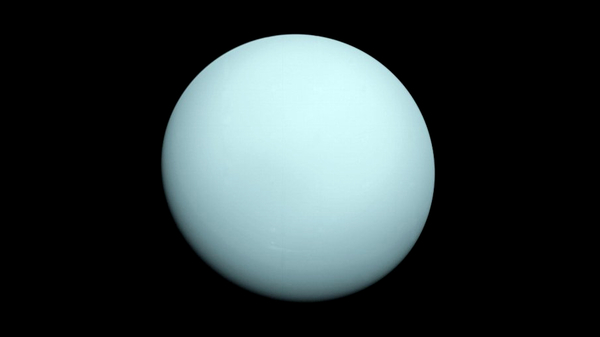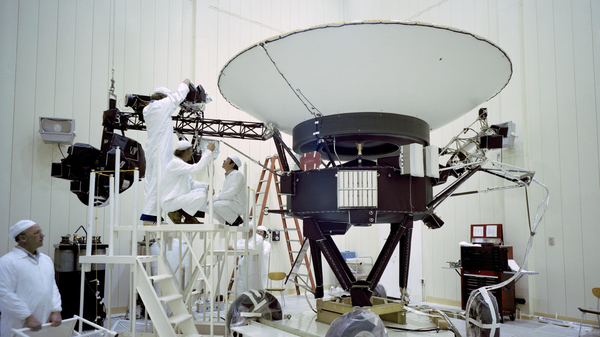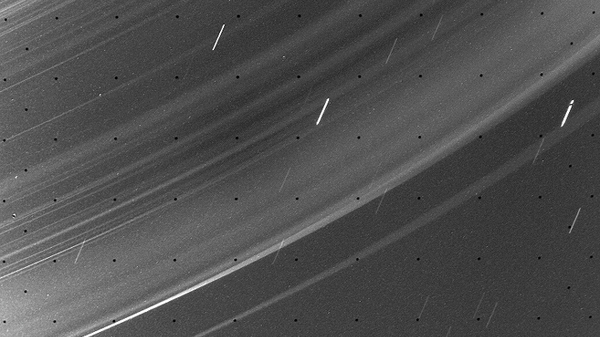Uranus: The Sideways Planet
Uniquely within the solar system, Uranus is tilted by about 90 degrees and appears to lie on its side as it orbits the Sun.

Uranus showed a plain face when the Voyager 2 spacecraft flew by in 1986.
©NASA/JPL-CALTECH
A Brief Overview of Uranus
Uranus is the seventh planet from the Sun. It is the third-largest in terms of diameter, and the fourth-largest in terms of mass.
Compare the sizes and order of the planets
Among the solar system’s four giant outer planets, Jupiter and Saturn are mostly made of hydrogen and helium. They are known as gas giants. In contrast, while Uranus and Neptune have atmospheres of hydrogen and helium, these planets consist mostly of slushy, rocky, icy materials. They are called ice giants.
Where Is Uranus in the Sky?
Find and track Uranus with our Interactive Night Sky Map
Check the weather in your town or city
When Is the Best Time to See Uranus?
Uranus isn’t a bright planet. In perfect dark-sky conditions, it is just visible with the naked eye as a faint blue dot. In general, however, binoculars or a small telescope are required to see it.
A good time to spot Uranus is when it is high in the night sky. The best time is around midnight when the planet is at or close to opposition, the period when Uranus and the Sun are on opposite sides of the Earth. Oppositions of Uranus happen every 370 days or so.
At solar conjunction, the planet passes behind the Sun, as seen from Earth, and is completely invisible for a few weeks.
Next solar conjunction: May 22, 2026
Next opposition: November 25, 2026
Previous opposition: November 21, 2025
Previous solar conjunction: May 17, 2025
How far is Uranus from Earth right now?

There is much we don’t know about Uranus and Neptune. This is because only one spacecraft, Voyager 2, has ever flown by these planets. The probe is seen here about five months before its launch on August 20, 1977.
©NASA/JPL-Caltech
How Long Is a Day and a Year?
Like all the planets, Uranus is tilted. But whereas Earth’s axial tilt is a moderate 23.5 degrees or so, Uranus has a tilt of around 97.8 degrees. This makes it appear that the planet is spinning on its side as it orbits the Sun.
Uranus takes about 17 Earth hours to complete one spin. Uranus and Venus are the only planets in the solar system with retrograde rotation. As seen from above the Sun’s north pole, they spin in a direction (clockwise) opposite to the direction of their orbit around the Sun (counterclockwise).
A tropical year for Uranus is about 30,589 days, which is approximately 84 Earth years. The planet’s sideways spin means it has a unique pattern of seasons and solar days.
Around the solstices, which come about every 42 years, almost an entire hemisphere of Uranus is in permanent sunlight, with the other in permanent darkness. Around the equinoxes, both hemispheres have about eight and a half hours of day, followed by eight and a half hours of night.
How Many Moons Does Uranus Have?
There are 29 known moons orbiting Uranus. The most recently discovered moon was found by the James Webb Space Telescope in 2025. The largest moon, Titania, is about half the diameter of our own Moon.
Uranus also has rings, although these are dark, faint, and difficult to see.

Voyager 2 took this close-up of the rings of Uranus during its flyby on January 24, 1986. The width of the frame is about 10,000 km (6200 miles). The short streaks are stars appearing to move in the background.
©NASA
Human Exploration of Uranus
Uranus was discovered by William Herschel in 1781. It was the first “new” planet to be discovered, since Mercury, Venus, Mars, Jupiter, and Saturn have been known throughout human history.
Astronomers had spotted Uranus on previous occasions but had mistaken it for a star. Herschel initially thought he had discovered a comet rather than a planet.
Within the astronomy community, “Uranus” is generally pronounced with the stress on the first syllable, not the second (“YUR-unus”).
So far, there has only been one spacecraft mission to Uranus. Voyager 2 made a flyby during a “Grand Tour” of the outer planets between 1979 and 1989.
How Long Does It Take to Get to Uranus?
In the late 1970s and 1980s, an alignment of the planets occurred that enabled Voyager 2 to use gravity assist maneuvers to visit Jupiter, Saturn, Uranus, and Neptune. The spacecraft reached Uranus in about eight and a half years.
Voyager 2
- Launched: August 20, 1977
- Arrived: January 24, 1986 (flyby, closest approach)
- Journey time: 8 years, 5 months, and 4 days
All dates are shown in UTC.